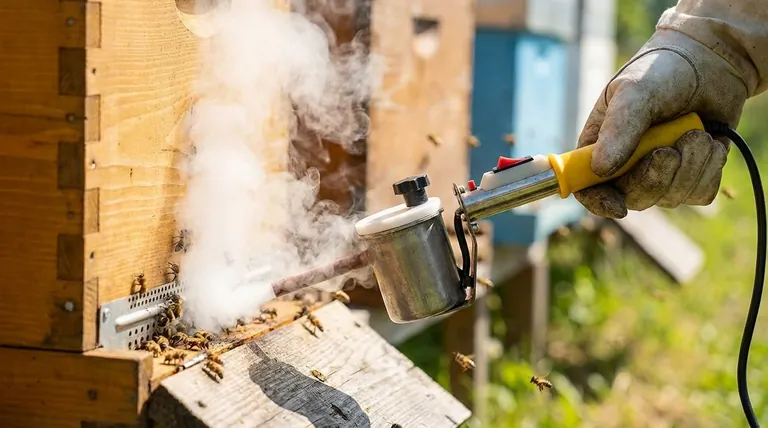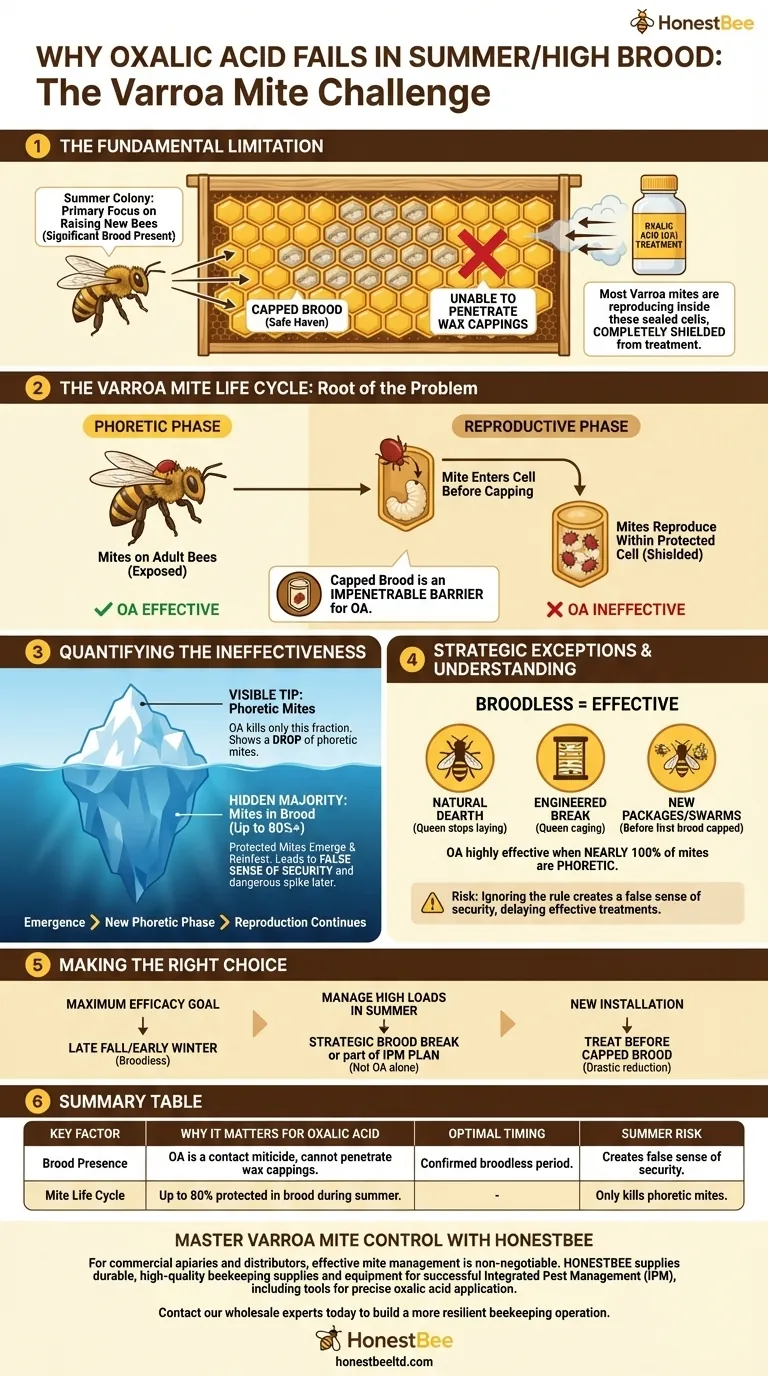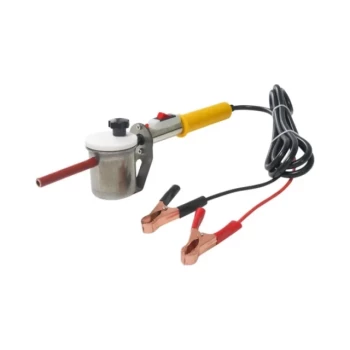The fundamental limitation of oxalic acid is its inability to penetrate the wax cappings of brood cells. During summer, a honey bee colony's primary focus is raising new bees, meaning a significant amount of brood is always present. Since most Varroa mites are reproducing inside these sealed cells, they are completely shielded from the treatment, rendering it largely ineffective.
The effectiveness of an oxalic acid treatment is not determined by the season, but by the presence of brood. It is a powerful tool against mites on adult bees (phoretic mites), but it is useless against mites reproducing within the protective confines of a sealed brood cell.

The Varroa Mite's Life Cycle: The Root of the Problem
To understand why timing is critical for oxalic acid, you must first understand the two distinct phases of the Varroa mite's life. The entire challenge revolves around which mites you can actually reach.
Phoretic vs. Reproductive Mites
A portion of the Varroa mite population is always in a phoretic phase. This means they are physically attached to adult bees, feeding on their fat bodies and waiting for a chance to enter a brood cell.
The more dangerous phase is the reproductive phase. This begins when a female mite enters a bee larva's cell just before it is capped. Once sealed inside, she lays multiple offspring, which mature and mate within the cell.
Why Capped Brood is a "Safe Haven"
The wax capping that seals a pupating bee in its cell also creates an impenetrable barrier for the mite family inside.
Oxalic acid, whether applied as a vapor or a dribble, is a contact miticide. It kills the phoretic mites riding on the adult bees but simply cannot get through the wax capping to harm the mites reproducing within.
Quantifying the Ineffectiveness During Brood Rearing
Using oxalic acid during a heavy brood period isn't just slightly less effective; it can be profoundly misleading. You are only addressing a small fraction of the total mite infestation.
The "Tip of the Iceberg" Problem
Treating a colony with heavy brood is like treating only the visible tip of an iceberg. You will see a drop of phoretic mites and may believe the treatment was successful.
However, the vast majority of the mite population—up to 80% or more during peak summer—remains hidden and protected in the brood. These mites will emerge with their host bees and quickly repopulate the colony.
The Cycle of Reinfestation
A single summer oxalic acid treatment does not solve the underlying problem. The protected mites emerge, enter a new phoretic phase, and the cycle of reproduction continues, often leading to a dangerous spike in mite levels by late summer or early fall.
Understanding the Trade-offs and Strategic Exceptions
While the general rule is to avoid oxalic acid when brood is present, there are specific scenarios where it can be used strategically. Ignoring the rule without understanding the context is a common pitfall.
The Risk of a False Sense of Security
The greatest danger of improper summer use is developing a false sense of security. A beekeeper sees a mite drop after treatment and assumes the colony is safe, delaying the use of more effective, brood-penetrating treatments until it is too late.
The Power of a "Broodless" Period
Oxalic acid becomes highly effective any time a colony is broodless, regardless of the season. In these situations, virtually 100% of the mites are in the phoretic phase and exposed to treatment.
This can occur during a natural nectar dearth that causes the queen to stop laying, or it can be engineered by the beekeeper (e.g., by caging the queen for a short period). It is also the ideal treatment for newly installed packages or swarms before they establish capped brood.
Making the Right Choice for Your Goal
The decision to use oxalic acid should be based on a clear understanding of the colony's state and your specific management goal.
- If your primary focus is maximum efficacy: Apply oxalic acid during the late fall or early winter after the queen has naturally stopped laying and the colony is confirmed to be broodless.
- If you must manage high mite loads in summer: Do not rely on oxalic acid alone. Use it strategically during an intentionally created brood break or as one component of a larger Integrated Pest Management (IPM) plan that includes other treatments.
- If you are installing a new package, swarm, or split: Treat with oxalic acid before the first round of brood is capped. This is one of the most effective times to drastically reduce the starting mite population.
Ultimately, mastering Varroa control comes from aligning your treatment method with the life cycle of the mite.
Summary Table:
| Key Factor | Why It Matters for Oxalic Acid |
|---|---|
| Brood Presence | Oxalic acid is a contact miticide that cannot penetrate wax cappings. |
| Mite Life Cycle | Up to 80% of mites are protected inside brood cells during summer. |
| Optimal Timing | Treatment is most effective during a confirmed broodless period. |
| Summer Risk | Creates a false sense of security by only killing phoretic mites. |
Master Varroa mite control with the right equipment.
For commercial apiaries and distributors, effective mite management is non-negotiable for colony health and productivity. HONESTBEE supplies the durable, high-quality beekeeping supplies and equipment you need to implement a successful Integrated Pest Management (IPM) plan, including tools for precise oxalic acid application.
Contact our wholesale experts today to discuss your equipment needs and build a more resilient beekeeping operation.
Visual Guide

Related Products
- 12V Bee Mite Removal Evaporator Oxalic Acid Vaporizer for Bee Fumigation Treatment 180W Atomization
- Durable 12V Oxalic Acid Vaporizer for Varroa Mite Treatment Beehive Beekeeping Tool
- Oxalic Acid Vaporizer 12V for Bee Varroa Mite Treatment
- Heavy Duty 12V Oxalic Acid Evaporator Vaporizer for Bee Varroa Mite Treatment Beekeeping Fumigator Atomizer
- Adjustable Formic and Acetic Acid Dispenser for Bee Mite Treatment
People Also Ask
- Can oxalic acid vaporization be used with honey supers on the hive? Ensure Legal Compliance & Honey Safety
- What are the methods of administering oxalic acid against Varroa? Drip vs. Sublimation Explained
- What are the supposed benefits of fogging oxalic acid over the dribble method? Speed, Coverage, and Bee Safety
- What are the two popular methods for applying oxalic acid? Choose the Best Varroa Mite Treatment
- What should be done after applying the vapor? A Step-by-Step Guide to Sealing Your Hive



















